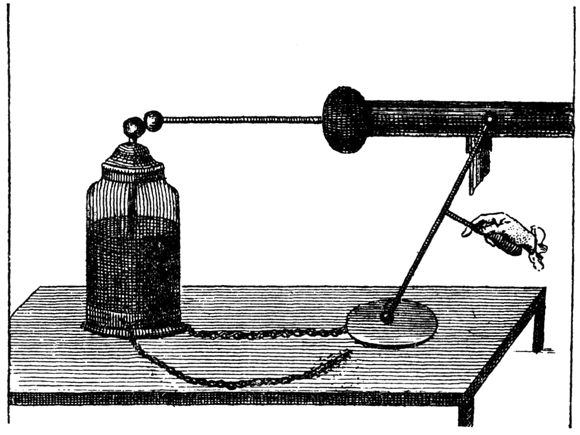To Benjamin Franklin from William Henly: Account of an Experiment, 7 October 1771
From [William Henly]
AD (incomplete): American Philosophical Society; remainder printed in the Royal Society, Philosophical Transactions..., LXIV (1774), 402–32
The experiment described below was part of a series that Henly undertook in 1771–72 to test Franklin’s theory about the path of the lightning discharge. The theory was under attack from Benjamin Wilson, who held that the discharge, given several alternative routes to ground, takes a single one, that which has the fewest surfaces to break through, is the shortest, and in which the property of the material provides the greatest conducting power.3 Franklin, on the other hand, seems to have held that any available conductor receives some part of the charge, although conducting power is a major factor in determining how much.4 Years earlier he had suggested that that factor varies in conductors,5 and he had recently proposed to Priestley and others that they determine the variation by exposing wires of the same thickness and different metals to equal and increasing charges until each wire was visibly affected.6 Henly developed the suggestion, and the experiment below enabled him to disprove Wilson’s hypothesis. This line of experimentation was a prelude, we believe, to the later theory of resistance.
Octr: 7. 1771.
I made the following experiment, having placed a very large Jar in contact with my prime conductor, I fixed to the outer coating of it an Iron Chain 10 or 12 Inches long which I also connected with a plate of Metal on which I intended to make the discharge, with my discharging Rod. This done I hooked another chain much longer and of Brass to the7 side of the Jar, and brought the end of it within 8½ Inches of the Metal plate. In contact with this end I laid a small Oak-stick 8 Inches long which I cover’d with Sawdust of Fir wood. On making the discharge upon the plate, both the chains8 were luminous through their whole lengths, as was also the sawdust which was cover’d by a streak of Light near an Inch diameter making a very pleasing appearance. I repeated the experiment several times. Perhaps if I had used a Bar of Iron instead of the Chain (first spoken of,) there might have been no appearance of light in the second Chain or upon the sawdust; especially as the electricity had full ½ Inch of air to pass through, before it reached the point of the stick. But from this experiment may I think be inferred the necessity of making the Conductors erected as a security to Buildings from the damage of Lightning, both of the best materials, and of a very sufficient substance;9 and, for this purpose, perhaps nothing will be found so proper as lead, which will remain in the earth many centuries without any considerable decay; and the tops of chimneys being covered with it,1 and furnished with a long, sharp-pointed rod of copper, or iron pointed with copper, which I think should extend at least five, or six feet, above the top of the chimney, or highest part of the building; a communication should be made from it by plates of lead, eight, or ten inches broad, with the lead, on the ridges, and gutters, and with the pipes which carry down the rain-water; which pipes should be continued to the bottom of the building, and there made to communicate, by means of other leaden pipe, or a plate of it, as before-mentioned, with the water in a well, the moist earth, or the main pipe which serves the house with water.

2. The fragmentary AD is in Henly’s hand and dated, and was part of a longer account, which he presumably sent to BF; Henly later revised the account slightly when he included the experiment in a series described in his paper in the Phil. Trans., where the illustration is on p. 388. We print the fragment from his MS, noting any significant changes he made in the finished paper, and the remainder from the printed text.
3. For Wilson’s theory see above, VIII, 239–63. For a later phase of the argument between Wilson and BF see the report on the Purfleet magazine below, Aug. 21, 1772.
4. Above, V, 76–7; XIV, 262. We say “seems” because one or two of BF’s other statements are open to a different interpretation.
5. Above, V, 523.
6. Priestley, History, ii, 368–71. Equal charges could be determined with Henly’s electrometer.
7. The printed text here adds “opposite.”
8. The printed text italicizes “both the chains,” and for good reason: their luminosity disproved Wilson’s theory. Brass was known to have less conducting power than iron, the brass chain was longer, and a charge passing by that route, via the oak and sawdust, had more surfaces to break through. If electricity behaved as Wilson thought, therefore, it would pass only through the iron.
9. The MS fragment ends here.
1. [Author’s note:] I mention covering the tops of chimneys with lead as a protection to the upper courses of bricks, from the effects of wind; and not as being of any essential service to the conductor, any farther than as it may assist in fixing the pointed rod, which is to be elevated above it, more securely.

![University of Virginia Press [link will open in a new window] University of Virginia Press](/lib/media/rotunda-white-on-blue.png)
